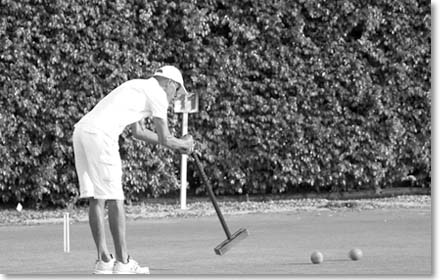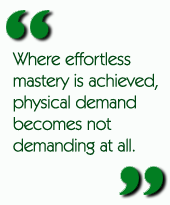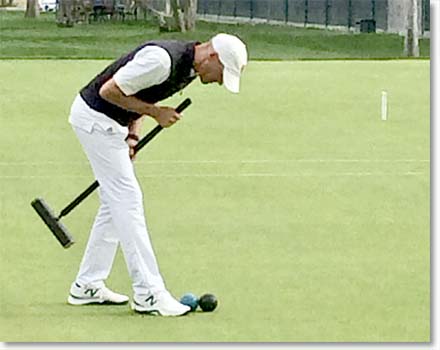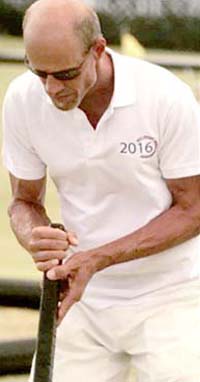

|
Back to |
| The Front Page |
| People |
|
Improving your stroke with Inspired Practice |
||||||
|
by Daniel Pailas photos courtesy of Daniel Pailas
|
||||||
|
||||||
I was told that Dan was teaching swing technique and shot making at the Sarasota County Croquet Club, and I could believe that, because I had seen him practicing his own stroke for what seemed hours at a time at the National Croquet Center. And he had lots of students in Sarasota and Denver. So I should not have been surprised when I got a long answer to what I thought was a simple emailed question: "What everyone knows about you, Dan, is that you are insanely rigorous on the matter of stroke practice. Do you believe a perfect stroke can be achieved with all that practice and that the perfect stroke will bring home the game in the event and the ranking?" His answer resulted in this article, which deliberately retains the Pailas vernacular.

|
I feel that if we love what we're doing, and if we want to perform at a level at which we feel we are capable, why not endeavor to be the very best we can be, right? For me personally that means rigorous solo practice. And I feel very fortunate that I have the ability time-wise to commit to that. I mean, how lucky is that? Trust me, I am not lacking gratitude.
It's the same in music
Always borrowing from my experience of being a musician, which I have been for most of my life, my croquet endeavor is guided by both ambition for mastery and love of the craft. For me, those two combined facilitate inspired, disciplined practice.

|
| Daniel takes his shot at a target ball at his first Selection Eights Tournament in 2014, taking 1st place in the 6th block at the National Croquet Center. |
As a lead guitar player, I play my best when I am playing 4 to 8 hours a day six or seven days a week. For me, lead guitar is infinitely more difficult than croquet or anything else for that matter. So, putting in a bunch of hours with croquet feels natural for me.
These days I am not practicing guitar as much unless I'm gearing up for some jam session, musician gathering or gig. In my earlier life when music was my profession, my identical twin brother and I, aka Double Dose, would consistently exceed that. One can get to a point on their instrument, for instance for me with the guitar, where the plectrum and the muscles and bone structure of the hands and arms seem to merge into a collective highly effective singular unit with the guitar.
 This is where effortless mastery is experienced; where the physical demand becomes not demanding at all. But man, it takes many, many hours of guitar practice to get there and stay there. Many of us have likely had this experience with our mallet, when command of the mallet and our body is so complete that we can do no wrong, hitting everything effortlessly. For many people, I'd guess that experience of mastery may be fleeting and intermittent.
This is where effortless mastery is experienced; where the physical demand becomes not demanding at all. But man, it takes many, many hours of guitar practice to get there and stay there. Many of us have likely had this experience with our mallet, when command of the mallet and our body is so complete that we can do no wrong, hitting everything effortlessly. For many people, I'd guess that experience of mastery may be fleeting and intermittent.
Being freed from the physical demands, and after strategy is well understood, resulting in less mental demand, the mind can then become silent and free from thought-distraction. That leaves an opening for a sort of "empty vessel" navigating the lawn or musical instrument. I feel this is where being present, or having presence has the potential of delivering exceptional performance because mental noise has less or no impact. I feel this defines being in "the zone", where focus is maximized and distraction is minimized.
Focus results from not being distracted. Distraction often is a result of thinking. That's not to claim that I am always successful at being in this silent zone, quite the contrary. But I usually know when I am and I tend to execute very well in "the zone".

|
| Daniel takes croquet with a half roll at the 2019 Desert Classic Association Croquet Tournament at The Mission Hills Croquet Club: "Gaining accuracy when taking croquet greatly facilitates running a well-groomed break. For me, part of that process has been developing beyond a 'that ought to do it' mentality regarding execution to a more precise demand on the outcome of a stroke. Of course, this takes practice." |
 My current hypothesis is that conscious breathing may be the most powerful means of facilitating getting into "the zone". I'm currently trying to incorporate regimented breathing into my routine. Certainly, we all struggle with tension in competition. It's hard to think our way out of that tension. Saying to ourselves "I've got to relax" may in fact cause more stress. Conscious breathing may be the perfect antidote.
My current hypothesis is that conscious breathing may be the most powerful means of facilitating getting into "the zone". I'm currently trying to incorporate regimented breathing into my routine. Certainly, we all struggle with tension in competition. It's hard to think our way out of that tension. Saying to ourselves "I've got to relax" may in fact cause more stress. Conscious breathing may be the perfect antidote.
Though that hasn't solved the stress issue for me, I am certain some conscious breathing helps reduce it. Currently I'm finding that a long, measured exhalation is delivering a much higher success ratio on hoop approaches and more.
For love of the craft
Doing what I love, I take solace in knowing I have given it my all, and I find that to be rewarding. If love is the predominant motivating force, we're much less likely to tire from the activity, because the activity brings joy, and joy is energizing. So, for me personally, giving it my all is relatively easy provided the fuel is love. The very best musicians play their instrument constantly--honestly, that tends to be their main activity, morning, noon and night. This probably applies to the best athletes as well.
 Wouldn't it be awesome if someone sponsored aspiring croquet athletes to train full time with coaching and more, something like the way Olympic athletes train? That surely would impact the US Team tremendously!
Wouldn't it be awesome if someone sponsored aspiring croquet athletes to train full time with coaching and more, something like the way Olympic athletes train? That surely would impact the US Team tremendously!
So, I do believe one can achieve some version of a perfect swing that will result in a higher percentage of challenging roquets. If we want to be competitive on the world stage of Croquet, then we can kind of measure that by achieving a very high percentage of hitting in. I spoke once with one of the best players in the world and he reported that when he was developing his roqueting and hit-in skills he would regularly practice that specific skill 3-5 hours a day!
Believe it or not, I've never been quite that obsessed! But I do try to incorporate an hour or so of swing training and target practice in each practice session.
Have I reached my envisioned destination with my swing? I feel I'm always improving, so perhaps I never will. I seem to get these swing epiphanies where it seems I've arrived at a higher level of consistency. But that doesn't always stick. I am reasonably happy with where I am currently, but I still struggle with consistency.
That hit-in skill is so rewarding, because there are few things as satisfying as hitting a ball 30 yards away, especially if it leads to winning a game as a result.
And imagine how much better it feels if you have a degree of certainty about it. Practicing your swing--getting it as consistent as you possibly can--takes you a long way toward that experience of certainty.
|
How effective is your stalk?
As I've developed as a player, I have deepened my connection to stalking as a primary source of aiming. I have to set my feet well and have a heavy and narrow feel in swinging the mallet, while allowing for the back swing to complete rhythmically with a smooth follow through, with my head and shoulders down in order to purposefully look at the ball. Succeeding in all that gives me the best odds at achieving the hit-in. The challenge of course is to be free of concern and caution.
Certainly, many of us have had the experience many times when, beforehand, we pretty much know we are going to roquet that distant ball as we approach to set our feet. Everything seems to line up perfectly in advance, including that sense of certainty. This sense of certainty may in fact be a fundamental aspect of successfully hitting in. If we aren't certain, then there's a pretty good chance we are doubting or worse, we aren't trusting. Likely, the best world to inhabit is simply to have a quieted mind, where the clarity of a stillness in one's focus leaves little room for doubt . If you want to check in about how effective your stalk is, try playing a game of "stalk only golf" in which stalking is the only form of aiming. Approach the ball, but once the feet are near the ball, no checking the aim is allowed, either by raising the mallet or looking at the target, including hoops! The head and shoulders must also stay down through the entire swing, only at the striker ball. Failing to do these results in a fault and loss of stroke. You will certainly learn something about the quality of your stalk in playing "Stalk only Golf" or doing target practice this way. Winter 2021 at Sarasota - with and without bisques
So, here were two trajectories. I heavily instructed my students in using bisques in both games! While many were reluctant at first, soon they realized what a functional and productive tool bisques are. Bisques help the developing player to succeed at a time when he or she doesn't have the physical skills yet to accomplish the objective without bisques. The students discovered the fantastic way that bisques allow them to conceptualize where they want the balls moving to in building or running a break. But then, if failing to accomplish their game plan, using bisques allowed my students to reconfigure the development of the break as many times as needed to accomplish the goal of then running the break. This proved to greatly catalyze comprehension of break play strategy. Additionally, they all have discovered that bisque numbers organically decline as skill improves! In other words, it becomes self-evident when bisques are no longer needed because the student is building breaks and running breaks with fewer and fewer bisques. Once bisques are used only to build breaks and not so much to run breaks, that's a good indication that, potentially, soon building breaks won't require the bisques either. Ten of my students competed in the Sarasota County Croquet Club's Association Croquet tournament in March of 2021 after only three months of coaching! Then, I was pleased to see that 8 of them--7 out of the twelve players in the entire First Flight--competed in the Association Croquet Nationals at Sarasota in April. The 8th student competed in the Championship Flight! The Incentive Bisque In using bisques for the American Rules/Six Wicket game , I invented a bisque called the "incentive bisque". The "incentive bisque" can be used only if the player is building a break, running a break, or setting up partner ball with a break. In this way, players who resist growing into break play don't get the benefit of using bisques. In a way, it's punitive. Only those who take the risk of break play get to use "incentive bisques" which when used, automatically clean their striker ball of deadness at turn's end. Additionally, my students at both the Denver Croquet Club and Sarasota Croquet Club have all learned to appreciate my emphasis on the mantra "rush the ball to the rush line of the next ball you're rushing" so that then, when taking croquet, the striker ball rolls into position for its next rush within the " cone of make-ability" of that ball's rush line." |
Daniel Pailas started competing in Croquet in 2014. He was awarded USCA Rookie of the year in 2015. He then qualified and competed in the World Championship in 2016. Currently he is coaching and training at the Sarasota County Croquet Club in Florida and at the Denver Croquet Club.

